VALLEY OF FIRE (Day 2 - part 2)
We drove a short ways down the road to our next stop: Clark Memorial
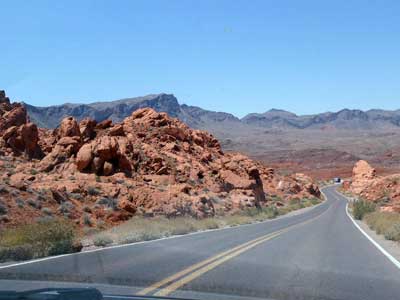



Near here is the Arrowhead Trail ... and a memorial for John J. Clark
In 1914, the Arrowhead Trail opened as the first all-weather automobile road in the U.S., connecting Los Angeles and Salt Lake City. It passed through this area so tourists could see the petroglyphs, pueblos and prehistoric salt mines. It was closed off in 1924.
John was born in Canada in 1844. He enlisted in the New York Infantry in 1862 and served in the Civil War. He was honorably discharged in 1863 after being shot in the hand and contracting typhoid fever. He then moved to southern California. In 1915, while traveling from Bakersfield to Salt Lake City, he stopped near here. He tied his horse to the back of the wagon and wandered around, probably looking for water. He didn't find it, for he crawled under his wagon and died. He wasn't found for several days.


Next came the historic cabins.



These 3 buildings were constructed by the CCC (Civilian Conservation Corp) soon after the area became a state park in 1935. They're built from native sandstone and were used to shelter campers and visitors to the park. Around 9,000 people visited in 1936.

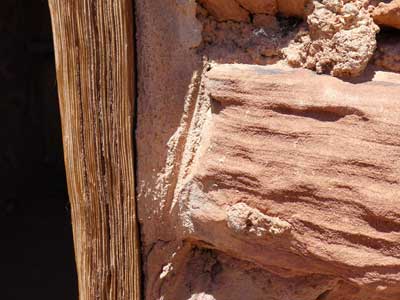








On the rocks behind the cabins were numerous petroglyphs. These are images chipped or scraped into the rock, as opposed to pictographs which are painted.
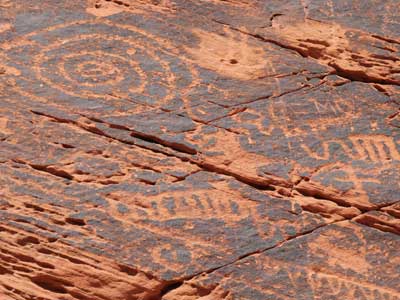

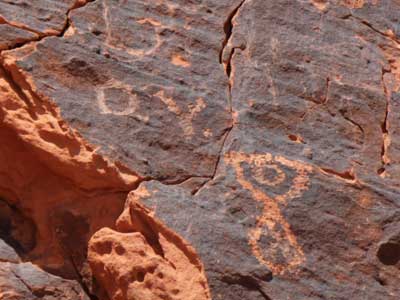

By scratching through the black "desert varnish" (a dark stain that sometimes coats the sandstone walls), the red rock beneath is revealed.


We turned onto White Domes Road and stopped at the Visitor Center where we spent some time cooling off and enjoying the wonderful exhibits.

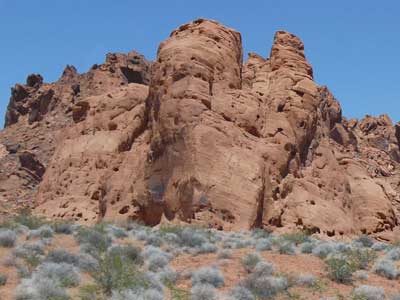



The high grey ridge across the valley is the oldest exposed rocks in the park, dating back 500 - 250 million years ago. The red rocks are younger, laid down between 250 - 66 million years ago.


600 million years ago, the sea invaded this area. It advanced and retreated over the next 400 million years. Most of the grey rocks are limestone and contain the remains of countless sea plant and animal life. When the seas retreated for the last time (about 200 million years ago), this region became a plain of sand, silt, clay and gravel. 70 million years ago, the mountains were then pushed up in a major thrust, as an oceanic plate slid eastward beneath the western edge of North America along the California coast. After that, things began to erode, resulting in the views we have today. The grey mountains are currently 10,000 feet (that's nearly 2 miles) shorter than they once were.


Humans have been coming here for at least 4,000 years. The desert environment can only support a small number of people, usually extended families or small groups of relatives.
The Gypsum people (4,000 - 1,800 years ago) were nomadic hunters and gatherers who lived in caves and rock shelters. They hunted bighorn sheep and carved the images we saw on the rocks. As the desert climate became drier, food and water became scarce. The people did not adapt and the culture died out.




The hunters used spears and a spearthrower called an atlatl. ... Replica of a figurine made of twigs and wrapped with grass (original is 3,900 - 4,000 years old)
The Basketmakers (2,000 - 1,450 years ago) came next and adapted well to the dry climate. They relied more on small animals and plants. They learned to plant seeds and hence became less nomadic. They didn't do well in this valley, however, since this area had no streams (hence not suitable for agriculture). Along with baskets, they also wove sandals from plant fibers.
The Anasazi-Pueblo people (1,500 - 850 years ago) hunted with the bow and arrow (sending a smaller point farther and more forcefully than a spear). They developed pottery and had trade networks. They hunted here in the springs and falls but spent the summers in the nearby mountains which offered a break from the heat.


Basketmaker sandals ... Anasazi-Pueblo pottery
When the Southern Paiutes (900 years ago - present) arrived in southern Nevada, the Anasazi-Pueblo dwellers were still here. But because the Paiutes were nomadic, they were more flexible when a drought hit, for example. The Anasazi-Pueblo farmers eventually moved east and south in search of more regular rainfall. The Southern Paiutes call themselves Nuwuvi (meaning The People). They moved seasonally, following the food.



(right) Bighorn Sheep


Artifacts ... and a model of Paiute camp about 1400 A.D.


A woman cooks over an open fire ... while a hunter returns with a bighorn sheep (notice his sandals!)


A grandmother makes a basket ... and a child plays with a hoop
return • continue

